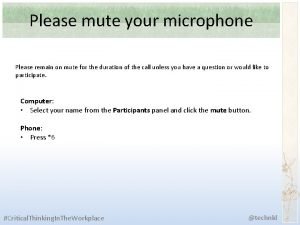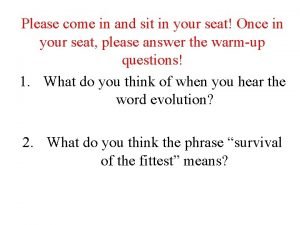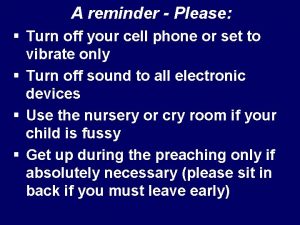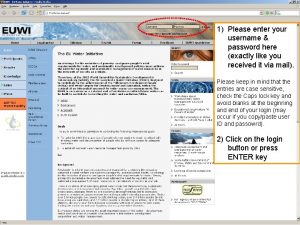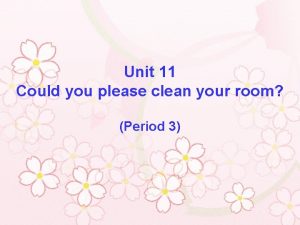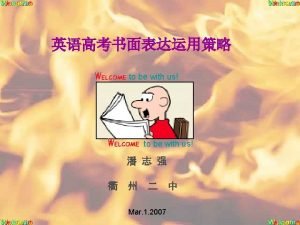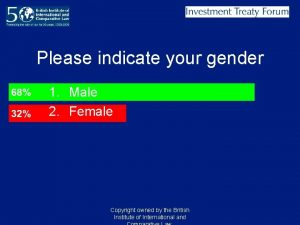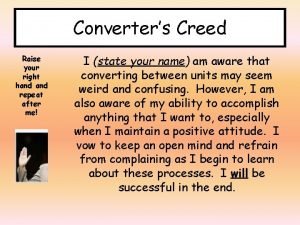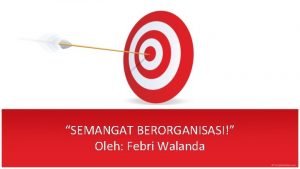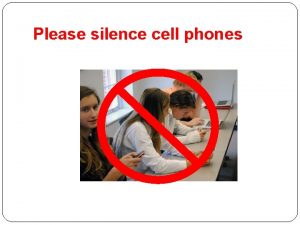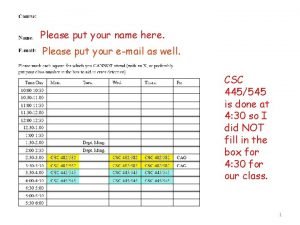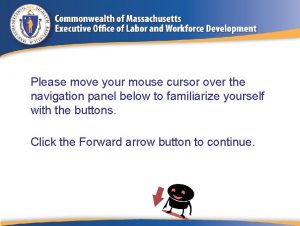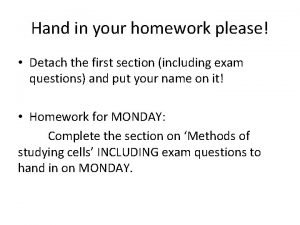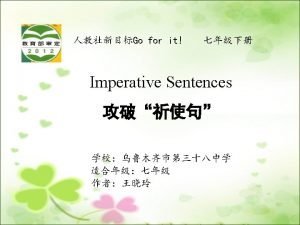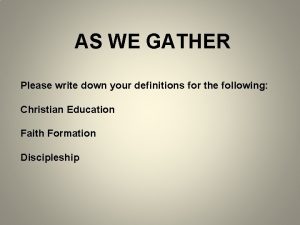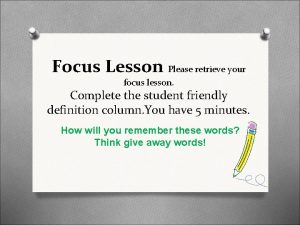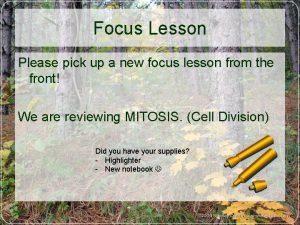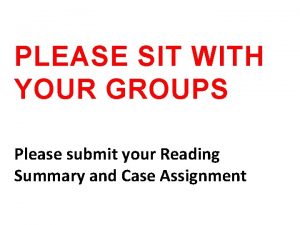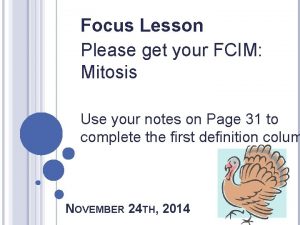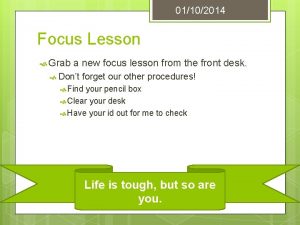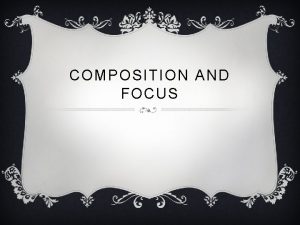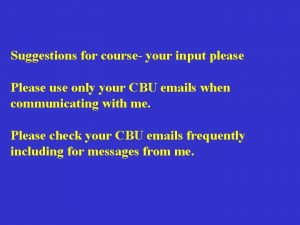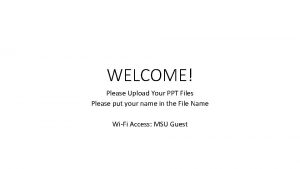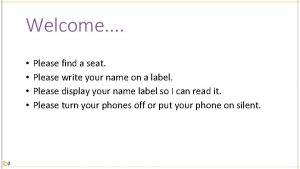Focus Lesson Please your focus lesson from the









































- Slides: 41

Focus Lesson Please your focus lesson from the front desk. Use the information in each of these columns to help you complete the final column Take it to the Next Level. Remember our procedures! You should be working when that bell rings.

Home Learning • Last class we learned about Biotechnology. • Your only Home Learning was to STUDY VOCABULARY to prepare for your quiz today.

Daily Objectives • SWBAT demonstrate the use of scientific vocabulary. • SWBAT explain how genetic variation, overproduction of offspring, and struggle for survival affect natural selection. • SWBAT explain the concept of adaptation and its relationship to environmental factors.

How will we get there? Last Class This Class • Page 16: CSI Crime Lab • Page 17: Biotech Notes • Complete FCIM • Vocab Quiz: Protein Synthesis, Mutations, Biotech • Page 18: Butterfly Activity • Page 19: Notes: Natural Selection • Absent? You need to see the website or stay during tutoring hours • Home Learning: • Study Vocabulary

Vocabulary Quiz • Clear your desk of EVERYTHING except for a writing utensil. • I will supply the paper. • You will have 10 minutes to provide me five definitions. • Each word is worth 2 points for a total of 10. • When you finish flip it face down on your desk.

How does all of this affect the population? • We now know what DNA does, how it can change, and how it impacts our physical traits. • But why does all of this matter?

Butterfly Activity Goal: Can you design a butterfly that I cannot find in the classroom? Rules: • You can use anything in your pencil box, or the extra colors up front. • You cannot put your butterfly under, behind or inside of anything to hide it. • You will have 5 minutes to decorate your butterfly. • You may cut out the shape, or leave it as a square. • You will tape your butterfly up while I am out of the room. • I have two minutes to move around the room to find your butterfly. If I can’t find your butterfly, and you’ve followed my rules you will get candy.

Page 18: Reflection On Page 18 write a paragraph (5 -8 sentences) to explain what we learned during this activity. Use the questions below as a guide. When you’ve finished double check that you’ve used complete sentences, and HIGHLIGHT any vocabulary you’ve included in your response. • What do you notice about the butterflies I was able to find? • What do you notice about the butterflies I wasn’t able to find? • Which butterfly would survive best in this environment? • Which phenotypes would be passed down to the next generations? • What controls the phenotypes of an organism?

Page 19 Notes: Darwin and Natural Selection

Darwin 1831, HMS Beagle Expedition from England to map coast of South America Charles Darwin observed differences among island species. • He began to perceive adaptation to the environment and the origin of new species as closely related processes.

Natural Selection Notes • Natural Selection What is natural selection? • When an adaptation/characteristic allows one organism to survive and reproduce better than others The 4 main principles of natural selection are: Variation: Overproduction: Adaptation: Descent with modification:


Variation • Phenotypic and Genotypic differences that result from recombination or mutation.

PEPPERED MOTHS: NATURAL SELECTION IN ACTION!

PEPPERED MOTHS pre-industrialization Which moth would be more fit? WHY? ? ?

PEPPERED MOTHS post-industrialization Which moth would be more fit? WHY? ? ?

Focus Lesson Please your focus lesson from the front desk. Grab the new focus lesson. Use your notes, or the book to complete the definition column. Remember our procedures! You should be working when that bell rings.

Home Learning • Last class we learned about Natural Selection. • Your only Home Learning was to STUDY VOCABULARY.

Daily Objectives • SWBAT explain how genetic variation, overproduction of offspring, and struggle for survival affect natural selection. • SWBAT explain the concept of adaptation and its relationship to environmental factors.

How will we get there? Last Class This Class • Complete DNA FCIM • Vocab Quiz: Protein Synthesis, Mutations, Biotech • Page 18: Butterfly Activity • Page 19: Notes: Natural Selection • Start Non Mendel FCIM • Page 19: Notes: Natural Selection • Page 20: Brain Dump • Page 21: I. P. Worksheet • Page 23: Notes Genetic Change in Populations • Absent? You need to see the website or stay during tutoring hours • Home Learning: • Study Vocabulary

Variation • Phenotypic and Genotypic differences that result from recombination or mutation.

Overproduction • More offspring= better chance one of your offspring will survive to reproductive age • BUT more offspring also equals more competition • http: //youtu. be/gds 666 EIx 7 c

Adaptation: Darwin’s Finches • Darwin, was struck by the variation of traits among similar species. • Each island, which had its own unique environment, had its own version of the finch (with varying beaks) • Darwin concluded that species can adapt to their surroundings to better survive over time.

Descent with modification • Heritable traits- traits that can be passed down through generations Favorable heritable traits, those which make it more likely for offspring to reproduce, will be passed on and thrive. This creates variation from the common ancestor.

Artificial Selection • Selection of traits determined by humans • Not determined by the environment • Darwin artificially selected for traits in pigeons to see if he could control the phenotypes that would be passed down to the next generations. Darwin had some weird hobbies.

More Common Example of Artificial Selection • Selection of traits determined by humans • Ex – breeds of dogs, cats, crops, or birds

REVIEW: Brain Dump Top Half Page 20 • What does genetic variation mean? • What theory did Charles Darwin propose? • What kinds of traits can you pass down? • Which organisms are going to WIN THE GAME OF LIFE? Dump everything you know about natural selection on Page 20. Use color. Make diagrams. THIS IS YOUR REVIEW.

Independent Practice Page 21 • Complete the independent practice • The critical thinking question is the Most important question on this sheet Show me what you’re made of!!!

And now. . GENETIC CHANGE! Turn to page 23 in your notebook.

Sexual Selection • Certain traits increase mating success. (You already know this!)

Sexual Selection • Intrasexual selection: competition among males

Sexual Selection continued • Intersexual selection: males display traits to attract females http: //youtu. be/7 dx 2 CUMt. Z-0

Gene Flow • Organisms move into or out of a population Immigration= INTO Emigration= OUT OF

Genetic Drift is: • GENETIC DRIFT: Random, non-adaptive change in the gene frequencies (aka genetic variation) of a population • What do you think they mean by non-adaptive? • Usually reduces genetic variation • The genes get eliminated by chance • Affects smaller populations much more than large populations. • Two types: • 1. Bottleneck Effect • 2. Founders Effect

Example: • Population of flowers: Red and White • Through random chance the elimination of the white flower occurs (For example- Baby Steps on it!) • This loss in genes to a small population means that certain combinations cannot reproduce • Over time the small population of flowers will be all red.

1. The Bottleneck Effect • BOTTLENECK EFFECT: • A situation where a large population is drastically reduced in size • Could be a result of: • natural disasters - hurricane • Invasive species- locus • Epidemic- disease • Which does what to the genetic variation of the population?


2. Founder Effect • FOUNDER EFFECT: colonization of a new habitat by only a few individuals • Again: reduce of genetic variation • In the right circumstances it will lead to speciation and eventually evolution of new species • New environment - new challenges - different adaptations are beneficial - natural selection


Natural Selection vs. Genetic Drift

Independent Practice- Show me what you’ve learned! Page 22 • Create a Venn Diagram which compares and contrasts Natural Selection and Genetic Drift • Complete for home learning! • EXTRA CREDIT OPPORTUNITY: • Diagram an example of organisms which highlights the differences between the two. IT CANNOT BE ONE OF THE EXAMPLES WE GAVE IN CLASS.
 Raymond carver will you please be quiet please
Raymond carver will you please be quiet please Prolepsis
Prolepsis Integrated cost leadership/differentiation strategy
Integrated cost leadership/differentiation strategy Business level strategy cost leadership
Business level strategy cost leadership Actor focus vs object focus
Actor focus vs object focus Give us your hungry your tired your poor
Give us your hungry your tired your poor Type your answer in the chat box
Type your answer in the chat box Turn microphone on
Turn microphone on Please mute your microphone
Please mute your microphone Please mute your microphone
Please mute your microphone Please come in and sit
Please come in and sit Please sit down and your seat belts
Please sit down and your seat belts Hierarchical polyamory
Hierarchical polyamory Please mute your phone
Please mute your phone Please put your homework my desk
Please put your homework my desk Please turn off your cell phone in church
Please turn off your cell phone in church Please enter your username
Please enter your username What does the teacher say to get the attention?
What does the teacher say to get the attention? Please mute your phone
Please mute your phone Please clean your room
Please clean your room I've told you to clean your room a million times
I've told you to clean your room a million times Please your homework this afternoon
Please your homework this afternoon Ladies and gentlemen may i have your attention please song
Ladies and gentlemen may i have your attention please song Shel silverstein homework
Shel silverstein homework Please put away your books and come here
Please put away your books and come here Exclamation indirect speech
Exclamation indirect speech Please silence your phone
Please silence your phone Yes clean your room
Yes clean your room Trigonal bipyramidal shape
Trigonal bipyramidal shape Please put your phone away
Please put your phone away Please indicate your gender
Please indicate your gender Kindly confirm your attendance
Kindly confirm your attendance Please turn in your homework
Please turn in your homework Raise your right hand and repeat after me
Raise your right hand and repeat after me Please mute your phone
Please mute your phone Cell phone energy transformation
Cell phone energy transformation Please put here
Please put here Please move your pointer
Please move your pointer Please extend your warm welcome
Please extend your warm welcome Mitosis
Mitosis Open your books please
Open your books please Daniel aleshire
Daniel aleshire








